4/ Guideline & Methodology to create a dynamic community involved in researching, learning about and transmitting European cultural heritage
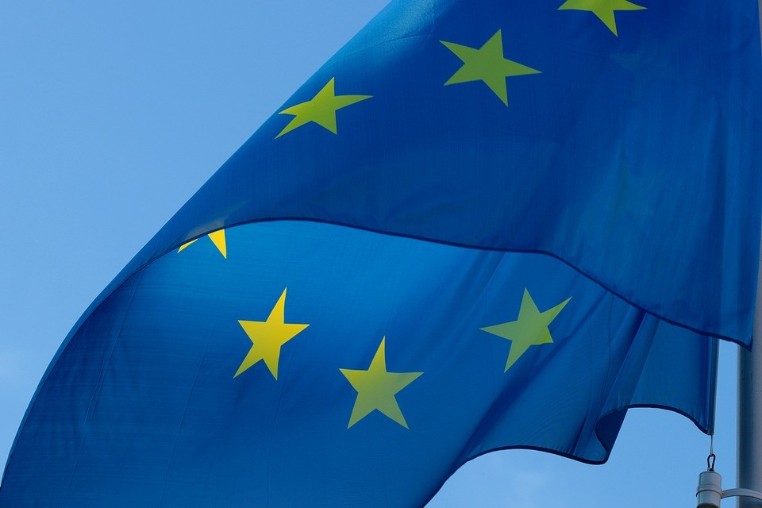
Here are the central themes and questions that have been outlined and discussed during our previous sessions in order to better understand Europe, and to make it better understood. Does "European heritage" allow us to further this understanding? Which relates to: Which shared heritage do European people claim as their own? However, through our discussions we have seen that these questions give rise to others and lead us to examine other issues. First question: What is "heritage"? Does it encompass all culture or is it rather a subsection of Culture, in the anthropological sense of the concept? Does each of the countries that we represent have their own specific approaches? Is the concept of "European heritage" relevant and operational? Second question: What is Europe? An even trickier question that has long drawn the attention of geographers, environmental engineers, historians, linguists, politicians, anthropologists, philosophers… As the French philosopher Edgar Morin said: "Europe dissolves as soon as we want to think of it clearly and distinctly".
 Robert BELOT is full Professor in Contemporary History at Jean Monnet University (Saint-Etienne, France) where he leads the Cultural Heritage Department. He is the director of a national Master in History, Civilization and Heritage and the coordinator of the Erasmus Mundus Joint Master Degree DYCLAM+. He holds the European Jean Monnet Chair 'EUPOPA' and he is the designer of the Propeace Project; he is member of the Research Center UMR CNRS n°5060 in Lyon (Environnement-Ville-Société).
Robert BELOT is full Professor in Contemporary History at Jean Monnet University (Saint-Etienne, France) where he leads the Cultural Heritage Department. He is the director of a national Master in History, Civilization and Heritage and the coordinator of the Erasmus Mundus Joint Master Degree DYCLAM+. He holds the European Jean Monnet Chair 'EUPOPA' and he is the designer of the Propeace Project; he is member of the Research Center UMR CNRS n°5060 in Lyon (Environnement-Ville-Société).
Le Patrimoine, plus que jamais, est une "histoire d'avenir"
(Heritage, more than ever, is the "history of the future")
- Identity Values History Heritage
Despite being a meeting of an academic nature, the subject dealt with took on a "civic" and educational dimension, as there were just two months to go before the European elections (May 2019). The ProPEACE Project was based on the observation, among European citizens, of a serious lack of self-knowledge, self-awareness, and ultimately, perhaps, self-esteem and self-control. It is, however, through history/Heritage that we can try to arrive at a better understanding of what Europe is: not a product of Providence or of biological, geographical or ethnic determinism, but "a historical fact" (Lucien Febvre) or a "cultural grammar" (Fernand Braudel). What if these current discrepancies of memory, which flourish in the contaminated soil of manipulated fear, could be analyzed to expose them as the perverse effect of the difficulty in understanding the history of Europe and accepting Europe as a historical creation?
It is often said that the worst of Europe (the Europe of fascism, Nazism, dictatorships and communism) was followed by the best of Europe, the Europe of peace, democracy and fellowship. The Europe led by "The Six" allowed the reintegration of Germany and Italy onto the European stage. The European Economic Community promoted the spread of democracy in Europe (Spain, Portugal). Following the fall of the Soviet Bloc, the European Union, for its part, played a fundamental role in the process of re-establishing the peoples of Eastern Europe within the cultural landscape of Europe. After the worldwide polarization caused by the Cold War, Europe once again became European and the European Union rose to become a geopolitical entity in and of itself.
The identity of Europe is linked to its historic heritage as Europe is first and foremost a product of history. This is why its relationship with history and with what is at stake metapolitically is essential in understanding the evolution of European sentiment today, particularly in a political context that is both tense and unpredictable, in which there is a tendency to question the ideological consensus on which Europe was founded. The ghosts of Europe's darkest history still haunt European memories.
From the outset it has been the Council of Europe, set up at the end of World War Two and the oldest European political organisation, that has positioned itself at the centre of this situation by creating, in 1959, the European Court of Human Rights, its "flagship institution". Although the European Union itself is hard to define, the key component that it wishes to promote as a condition for other countries joining it, and as its central philosophy, is its "values" (Article 2 of the TEU), which every member must respect and promote (human dignity, liberty, democracy, equality, the rule of law, respect of human rights). These values were drawn up in the European Union's Charter of Fundamental Rights (2000). In 2007, a decisive step forward was taken to try to define what constitutes "European Identity". The European Council of Lisbon had attempted to define it, while agreeing that a universal and unchanging definition was impossible. Their definition takes into account the historic dimension of the European reality:
"The term ‘European' associates geographical, historical, and cultural elements that collectively contribute to European identity; such sharing of ideas, values, and historical links cannot be condensed into a single definitive formula."
In fact, the history of Europe, both the remarkable and the detestable, constitutes the intangible heritage that marked the advent of Europe as a political entity. Post-war Europe was indeed built on the rejection and overcoming of a traumatic history that had led to the denial of its humanist values, as well as its weakening both morally and politically. The memory of this painful history was essential to guard against the risks of a return to nationalism and xenophobia; it had to be the link through which the European idea would develop to forge European citizenship. Today, Europhobic tropism appears to question this historical and axiological heritage, not so long ago deemed to be untouchable. We have to be vigilant. Peace and Freedom are not to be taken for granted: they are in constant construction.
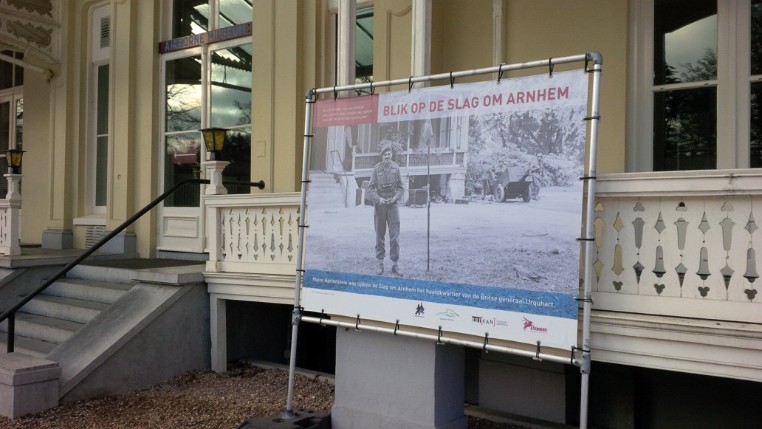
- HOW TO UNDERSTAND EUROPEAN HERITAGE AND MAKE IT UNDERSTOOD
The nature of "European heritage" needs to be debated and thoroughly studied. Indeed, as Europe has difficulty defining itself, political discourses on "European heritage" are deployed outside any defined framework. The 2007 Ipsos survey on "Europeans, Europe's heritage and European heritage" posed some very good questions but did not answer them (public "perception" approach): "Is there today a European culture? What does it consist of? Are these heritages different, overlapping, or is there a common, recognized source?"
In its Resolution CM / Res (2013) 67 revising the rules for awarding "Cultural Route of the Council of Europe" certification, the Council of Europe speaks of a "common cultural heritage" and refers to the existence of "European identity and citizenship". It states that "the understanding of European history must be encouraged based on its tangible, intangible and natural heritage, so as to reveal the links that unite different cultures and different territories within Europe". It does not, however, explain what these concepts really mean. This is something that all those involved in European education and heritage must work hard on to provide the answers.
We can start from the following basic definition: heritage is the set of tangible and intangible goods (past or present), cultural or "natural" that a group of men and women decide to conserve, value and transmit because they consider them representative of their identity; these goods are composed of both inherited objects and chosen objects (according to the process of "inverted filiation" proposed by Jean Davallon). The different concepts of Heritage would be analyzed and presented through a bibliography and a historiography that shows the evolution of these concepts from a chronological and socio-historical perspective, as Heritage does not exist in itself: it is an amalgam depending on the evolution of societies, world geopolitics and the phenomenon of globalization.
A triple, comparative approach needs to be taken from the perspective of heritage policies and practices:
- The policies/practices of European countries
- The policies/practices of non-European countries
- European policies/practices (The European Union and Council of Europe)
All stakeholders in the heritage phenomenon must be taken into account to achieve a multi-scale approach:
- Public stakeholders (Europe, individual States, local groupings, universities…)
- Association stakeholders (local associations, chambers of commerce…)
- Private stakeholders (Foundations, companies, private individuals…)
Current major heritage issues must be tackled. Although these issues are of global concern, which is the measure of today's world (for more on this, see the following article by Robert Belot: Heritage Abuse and Geopolitical Disorder at the Dawn of the Third Millennium), they are also particularly associated with the European cultural area:
- Illegal trafficking in cultural property
- Overtourism
- Marketing of cultural goods and sites
- Turning heritage into disneylands
- Catastrophe heritage (accidental, natural, technological, political: from Chernobyl to Notre-Dame in Paris)
- Pillaging of heritage during conflicts
- Europe faced with appeals for the return of ill-gotten cultural property
- Ideological destruction of cultural heritage
- Communist heritage and the restoration of heritage in the former communist countries
- Nationalist/micro-nationalist manipulation of intangible heritage
- Immigrant heritage in Europe and community acceptance of their heritage
- Heritage faced with fantasy and new television series
- Digitization of heritage and its appraisal
- Reclassification policies (architectural religious and industrial heritage) race for architectural, religious and industrial labels
- The race for public and private labels, national and international)
- UNESCO and the labelling policy in Europe
The increasing diversity in the field of heritage (following the incorporation of the intangible dimension into Heritage) and the pedagogical effectiveness (notably the inductive method) means that we cannot stick to the theoretical and notional dimension: it is strongly recommended to base courses or tutorials on concrete cases.
Special efforts, therefore, have to be made in:
- selecting differentiated subjects and singular objects (foods, events, traditions, politics)
- studying them on various levels: sites (rural, urban), monuments, landscapes (natural, cultural)
- linking the local with the global
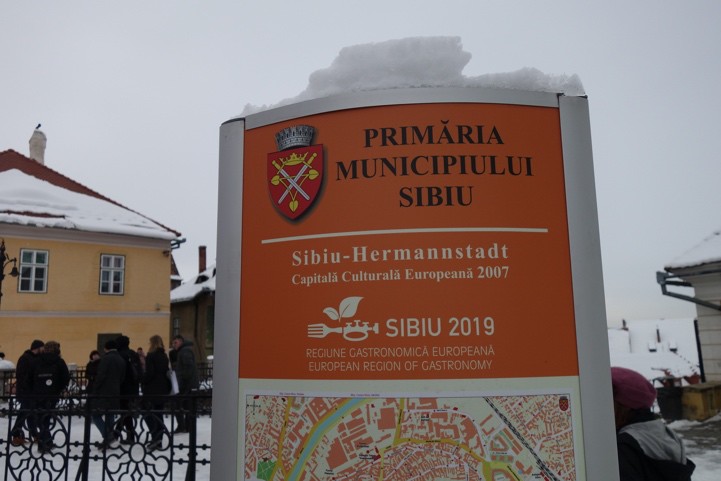
The Lexicon and the Virtual Encyclopaedia referred to in this MoOC give just a glimpse of the richness of this theme.
- The key role of the University
The lack of specifically trained staff means that universities do not have an adequate vision of the future and are slow to change their methods. Consequently, many European cultural projects do not develop as they should. The academic establishment needs to support this movement. The university must inform public policies on this major issue. A new field of research and teaching is opening up and the UE is encouraging it (ERASMUS+).
The aim is threefold:
- To develop a European conscience for a better understanding of what constitutes "European culture"
- To promote a knowledge of European policies and practices in this field
- To enable students to integrate the European scale into their professional outlooks
The aim is to strengthen and make the European context more visible in the educational offer of Universities and by creating specific degrees (masters) and/or disseminating the European question at all levels of education: from first year to the doctorate. Specific across the board awareness-raising courses can be created. Moreover, the European issue can be instilled in all disciplines through a comparative, not national-centred approach.
These courses can be organized around three lines of questioning:
- What is Europe (historically, culturally, politically, economically, scientifically…)?
- What national impact (on each country) do actions initiated by the European Union have?
- In what ways can Heritage (tangible/intangible, cultural/natural) help to better identify European values and open up professional outlooks?
All disciplinary fields are ultimately intended to be affected by the heritage paradigm (human and social sciences, law, architecture, management, political science, environmental sciences, arts, letters and languages, medicine, etc.). All students are potentially concerned. It would, therefore, be ideal to provide a system for validating their participation in the form of free ECTS credits within their degree course.
Innovative pedagogy focused on exchange, fieldwork, study trips, debates, internships, dissertations and meetings will be one way of building bridges between Universities and decision-makers (public/private). The university, thanks to the legitimacy it embodies and its ability to counter the disseminators of "fake news" and cognitive biases, must assume its role of influencer or "counter-influencer" outside its particular physical boundary. That is how the design of a website to allow the dissemination of courses, conferences and events, came about. We have to strive to combine three levels of collaboration and action:
- To better connect Education with Research: a doctoral seminar and summer University could be established around current heritage issues
- To better connect Higher Education with primary and secondary Education: by raising the awareness of students on teacher training courses and developing awareness-raising activities among teachers-researchers (or even PhD students) directed at schools and colleges.
- To better connect the University with civil society, associations working in the culture and heritage field, sites and museums and regional, public stakeholders.
Three broad bands of information and knowledge have to be envisaged:
- International scientific events (conferences, workshops) in which students are involved (in specific sessions) and information spread through publications (books and articles, print and online versions). That is how international networks can be created.
- A website that should be more than just a "showcase site". We need to build, with the students, a virtual space of information and exchange open to a wider public that can take on the role of public influencer, at the same time as providing a window onto the specific activity of each university and onto European heritage news. Blogging activity can also be added.
- Events designed from a public inter-generational approach: conferences for seniors at "leisure-time" universities; conferences for students training to become teachers or schoolteachers themselves; visits to important sites of European heritage; organizing "general public" exhibitions and conferences on 9th May and European Heritage Days; and making special efforts towards involving non-European students.
IV.FIVE FOUNDATION COURSES FOR A BETTER UNDERSTANDING OF THE CURRENT HERITAGE ISSUE IN EUROPE
These proposals are based on two current themes that underline the importance of understanding the issues of cultural heritage:
- The difficulty but interest that European countries (and therefore also the EU) have in considering and bringing about a European heritage that goes beyond national boundaries
- The need to raise awareness of the major problems facing cultural heritage.
The basic idea is that heritage does not only have an entertainment function and is far from being just the result of misoneist nostalgia. It has educational and identity-based virtues and can constitute an element favouring the emergence of a European consciousness.
1/ From historical conflict to consensual memory: the heritagization of European wars and conficts
We like to say that the twentieth century was the "century of extremes" in Europe: terrorism, world wars, anti-colonialist struggles, population displacements, cold war, ethnic and energy conflicts, the conflagration of the Middle East ... However, despite that unprecedented instability and violence, a new world was born, thanks to huge scientific, cultural and democratic advances. It is this paradox that this course wishes to reveal. It is not only necessary to analyze how conflicts developed, from the First World War to the war in Yugoslavia, but also to understand the ways in which the European project was able to establish an outlook of reconciliation and resilience. That project, in fact, promoted a community of axiological and democratic destiny by postulating a common heritage. The rejection of that conflictive and painful history and a return to the values ??of Enlightenment Europe were one of the foundations of the will to remake Europe. European history has produced "brilliant geniuses" but also "demons", "all light finding its equivalent in equal darkness" (Paul Hazard).
The heritage of the worst has been a major element in the process of the European rebirth and emergence of a political Europe. Contrary to theses that consider heritage as an effect of a "retrotopia" (Zygmunt Bauman) and a "nostalgia epidemic" (Sveltana Boym), European countries, in different ways and intensities, have shown that a lucid and painstaking enquiry into the memory of what divided and bruised can lead participation in the construction of a European citizenship. The case of Germany is particularly eloquent in this respect. Specific examples will be studied, such as the UNESCO World Heritage listing of Auschwitz; the Franco-Belgian World Heritage Site project for the burial and memorial sites of the First World War; or the Ring of Remembrance inaugurated in 2014 in Notre-Dame-de-Lorette which represents a change in the remembrance paradigm insofar as the names of dead combatants are no longer classified by nationality.
The British have worked extensively on the Battlefields Heritage issue as a way of promoting reconciliation between belligerents after conflict. For example, Albert Ogle ("Returning to Places of Wounded Memory: The Role of World Heritage Sites in Reconciliation", in Laurier Turgeon, ed., L'esprit du lieu/The Spirit of Place, Quebec, Presses de l'Université Laval, 2009, pp. 261-274), shows how heritage serves here as individual and collective therapy, mourning and at the same time rebuilding the social bond and community, transforming conflictive forces into unifying forces. The successes of the European Union are often poorly appreciated. And yet, it played a fundamental role in attracting the countries of the former Yugoslavia that had been torn apart at the end of the twentieth century to its project, or the European countries of the ex-soviet bloc that were seeking to constitute, through a dynamic heritage, the rejection of communist memory. We must ask ourselves if this heritage is not threatened today by a tide of European feeling symbolized by the rise of national-populism and centrifugal political forces that believe it possible to liquidate the communist heritage by resuscitating political figures that were the embodiment of collaboration with Nazi Germany (like Admiral Horthy in Hungary).
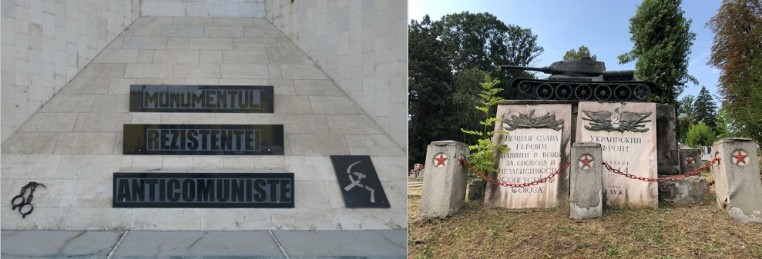
2/ Is Europe a major geopolitical player on the cultural plane?
Geopolitics is the analysis of the forms of power and the reconfiguration of poles of power. Power is not only "hardpower": it is also "softpower", i.e. the ability of one political entity to influence another through its model, its values, its creations, his history, and culture and heritage are major elements in the power of influence. The Cold War is an excellent example to illustrate this theme. It was an ideological and cultural war with Europe as the main theatre, which developed strategies for mobilizing intellectuals and artists on both sides (magazines, history, numerous demonstrations, books...). One great intellectual engaged in the anti-communist struggle, Arthur Koestler, recalled in 1950: "Our goal is to win over those who still hesitate, to break the influence of Joliot-Curie, on the one hand, and that of cultural neutralists such as Modern Times on the other hand."
Today, war is thought of in terms of competition and "market share". And Europe is not badly placed. Indeed, the attraction that Europe exerts on tourists is linked to its ancient history, to its varied landscapes, to its diversity, but also to the reputation of its cultural offer (museums, literature, exhibitions, monuments...) and of its university system, the oldest in the world. This power of attraction obviously produces economic consequences that are measurable in terms of Gross Domestic Product. Europe wants to maintain and increase its place in the global flows of cultural trade.
It is, therefore, necessary to pose, through this better-appreciated bias of the place of Europe in the world and the world in Europe and also through the perspective of the very latest events, two heuristic questions: What is Europe? What can she do? The analysis of heritage from a multi-focal approach is crucial in order to understand the European fact:
- Its geopolitical and historical framework
- Its system of values and institutions
- Its image and influence in the world
- Its tradition of artistic, architectural and techno-scientific innovation
- Its cultural and heritage policies
- The excellence of its reflection on the sciences of heritage
- Its skill in the area of managing cultural and natural assets
This clearly points to the existence of a "European heritage area", which will shed light on how the European model is disseminated throughout the world and appropriated by non-Europeans. Outstanding and specific examples of this are the Louvre Abu Dhabi or the Shanghai Power Station of Art. However, it is also worth comparing the weight of Europe in global market shares of culture, and especially compared with American power in this field (music and cinema). An example to ponder: on September 12, 2018, the European Parliament voted in favor of copyright protection, signing a victory against the American giants of digital technology. We do not know that the European cultural and creative industries occupy a powerful position in the economy and employment (especially among young people). A book to read: Jean-Noël Tronc, Et si on commençait par la culture ? Plaidoyer pour la souveraineté européenne, Paris, ed du Seuil, 2019.
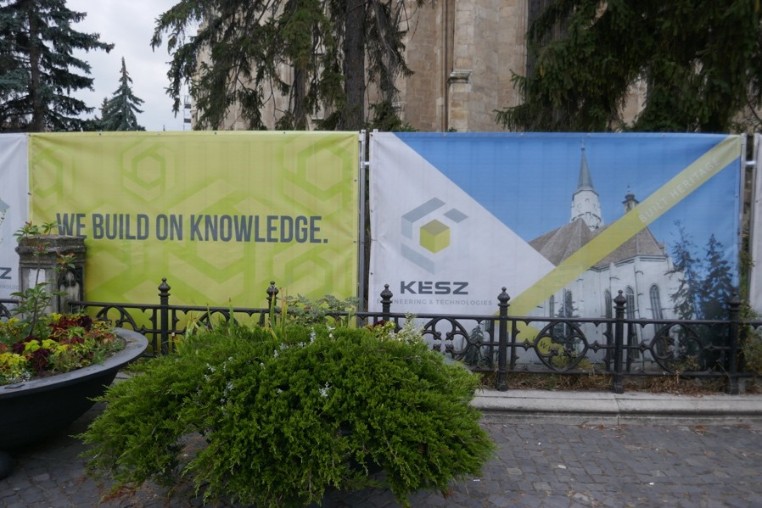
3/ Europe faced with the post-colonial and post-conflict challenge of returning heritage to countries of origin
The rebalancing of the heritage and tourism offer in territories outside Europe has triggered the development of new cultural landscapes: the phenomenon of restitutions. It was Europe that initially launched the movement through a policy of "spin-offs" and "franchising": Bilbao, Abu Dhabi, Dubai ... This process consisted of globalizing cultural interests at sites, where the commercial dimension were favourable. However, the old framework where Europe did the exporting remained. Today, in contrast, we are witnessing a strong movement towards the opposite direction.
Political decision-makers now intend not only to promote their heritage and their landscapes, but also to claim a "right to heritage", combining this with requests to Europe for the restitution of their cultural assets. Hence, President Macron's Ouagadougou declaration and, in its wake, the Sarr/Savoy report handed to President Macron in November 2018: The Restitution of African Cultural Heritage: Toward a New Relational Ethics. A geopolitical divide of a new nature is emerging in Europe, whose museographic heritage is largely the result of acquisition policies based on the balance of power (in particular colonization), resulting in certain countries and regions having been deprived of their cultural and religious property. These countries are not only wishing to benefit from the tourism/heritage manna linked to the new world market, but are expecting the restoration of justice and some kind of cultural equality. The issue is clearly about reappropriating identity.
The National Museum of Ethiopia (Addis Ababa), and its new gallery of palaeontology and prehistory (2004), designed in collaboration with French research centres, is an example of this new geopolitical context that involves cultural heritage and leads to new relationships (scientific and diplomatic) between Europe and the countries that were formerly subject to it. Since 2007, the Ethiopian government has been demanding the return of looted items following the suicide of King Tewodros II, who was defeated by the British army in 1868 (Battle of Magdala).
This new geopolitical situation will continue to grow. Means have to be put in place in order to look for solutions (legal, technical, diplomatic, museographic ...) as these cannot be solved by one country alone. UNESCO will have its part to play, but also the European Union, in particular. This movement of cultural reappropriation comes at the same time as the intensification of research into the origin of the Nazis stolen cultural property. In his report on stolen cultural property (March 2018) written at the request of Audrey Azoulay (then French Minister of Culture), David Zivie found a mixed response to the idea of restitutions among state institutions and museums, and proposed showing a real ambition to search, find, restitute and explain. The methodologies used (historical research, databases, international cooperation, compensation, restitution ...) could be used in many other areas. The ambition referred to is to nurture a global approach to the works plundered during the Second World War and the communist period in Eastern Europe, as well as the cultural goods collected in Africa during the colonial period, and other displaced cultural property whose location is in question.
4/ Europe, a complex heritage somewhere between unity and diversity
To understand Europe, its strengths and its weaknesses, we have to understand its foundations and the complex process that has led to today's Europe. This Europe is not the result of chance or the effect of a few people (as some new conspiracy theories tend to believe). This course should enable learners to acquire a general knowledge of Europe through a politico-institutional approach. The course could be structured upon two main axes: the history of the European idea and the most important stages of the European construct. The common thread interwoven into the entire course and the debates organized by the students would be the cultural issue:
- Does Europe have an original "civilisation" or can it be reduced to economic ambition?
- How has the historically plural and conflictive reality been able to engender a common ideal?
- At what moment did Europeans feel or wish to be Europeans?
- Which are the areas (of knowledge, art, science…) and the networks (philosophical, political…) from which the will for a European entity has been extracted and disseminated?
- How can a "certain European idea of man" be conceived while the definition of Europe is based on "dialectic", balance and "complexity"?
- How to unite without uniformising?
- How can very different and even antagonistic histories be combined?
This is the challenge facing those who are at the heart of institutional Europe and this is the source of the difficulties that have to be faced on a daily basis. European heritage allows us to understand that Europe is a point of equilibrium, constantly readjusted, resulting from a set of cultural tensions: unity/diversity; nationalism/universalism; religion/rationalism, Greco-Roman antiquity/Christianity; germanism/latinism; tradition/progress; individualism/idealism; continentalism/seafaring tradition; urbanism/ruralism; collectivism/freedom ... This complexity is at the heart of European Heritage and it helps to better understand why Europe has followed (and still follows) "the path of organized freedoms" (Denis de Rougemont). This complex heritage is an asset, but it is also one of the difficulties that Europe has to tackle in terms of collective identity. Post-war Europe has heritagised the worst of its history in order to re-establish its heritage of humanism and progress. Today, Europe is still struggling to heal the wounds of the post-Cold War era, as witnessed in the example of the Mostar Bridge or the diplomatic storm caused by moving the monument to Soviet soldiers in Tallinn in Estonia, but being aware of this allows one to change one's view of Europe today.
In order to better understand what constitutes the specific nature of European heritage and what is common to European culture, Europe has to be differentiated from other cultural areas, in particular the United States, Africa or Asia, so as to from concrete examples (urban structures, religious sites, political life, the role of women...).
5/ The new challenges of European heritage: mass tourism, territorial rivalry and profitability
Globalization, increased mobility, the emergence of a global middle class, the advent of social networks - all these factors have caused a very rapid development of global tourism. The milestone of one billion tourists was reached in 2013, and Europe is particularly affected by this phenomenon. Last year France welcomed 90 million tourists. The Louvre Museum has reached a record 10 million visitors. It is very good news. This shows a desire to see and get to know the culture of others. In Europe, Culture and Heritage are among the main sectors creating jobs and income for youth and the population in general. It is crucial to improve performance and to promote its sustainable development. However, there are also risks involved. The conference on mass-tourism was very enlightening on this point. Every country is concerned about this, saw in Iceland, for example, during our study stay. The logic of profitability has caused an upheaval in the social structure of cities and their identity.
Heritage is both a tool for territorial development and a source of income. However, it can also be a tragedy when taken to the point of saturation and pose a threat through over-exploitation, so disturbing the social and ecological balance. The question of measuring the economic impact of Heritage and its social effects (negative and positive) has become the subject of research and should be taught. The aim is to make students aware of the current tendency to promote the economic consequences that the development of world heritage tourism can generate. European analyses are particularly relevant at a time when there is a frenzied quest for distinguishing oneself, something that has turned into a veritable "race for labels" (UNESCO, Grand Site, European Cultural Route, European Heritage Site, etc.). Heritage seems to hold out the promise of manna from heaven, a major economic lever and attracting admiration. This tropism provokes competition between territories and sites, which it would be a good idea to analyze not only on the European but also on the global scale. More than ever, it is necessary to carry out an objective analysis of the real impact of the "spin-offs" of heritage in Europe and heritage economic policies in Europe.
A second axis of reflection must also be tackled and that concerns the very recent situation and consequences of "overtourism" caused by the increasing popularity of experiencing culture and heritage. This is an effect of the globalization of trade and rise in the power of a global middle class. The wealth and the economic spin-offs that it can generate have thus become a major challenge for territorial development and policies designed to attract visitors. A global market has gradually been structured, and global competition between sites has emerged. This has resulted, in particular, in a gradual change in the direction of tourist flows towards non-European areas, although Europe remains at the top of the list of world tourist destinations: France receives 90 million tourists, Spain 82.6 million, Italy 60 million. Measuring the counterproductive effects of the heritage craze has only just begun.
Heritage and cultural landscapes have never been so celebrated, exploited, or profitable before. They have become so popular that the over-exploitation of some sites, supposedly protected by World Heritage listings, now pose a threat to universally recognized assets. The logic of profitability has caused an upheaval in the social structure of cities and their identity. It is symptomatic that many governments now have a Ministry of Culture and a Ministry of Tourism, like Ethiopia. In Paris, the AirBnb phenomenon became a major political problem when it caused the disruption to the housing market of the first four districts of Paris and sparked conflicts between agents and uses. Santiago de Compostela has been emptied of its native inhabitants. Gentrification has caused a real estate boom in some major European cities (Barcelona, ??Dubrovnic, London, Amsterdam...), which has triggered hostile social movements. The mayor of Venice has requested the inscription of his city on the UNESCO list of endangered heritage sites. An anti-tourism reaction has also gained ground in non-urban sites, such as islands, which fear for their eco-system in this real estate boom. In Sardinia, numerus clausus or a limit on numbers has been applied on certain beaches. In Mallorca, slogans hostile to tourists can be read in the streets. Policies to limit flows are being devised: creation of quotas, prior registration, regulation of cruise ships, taxation at the entrance to certain neighbourhoods, limits on the duration of tourist accommodation rentals in private contracts. With the support of the local population, the Edinburgh City Council managed to impose a fee of £2 per room per night on all bookings.
The mass tourism caused by the heritage craze brings with it a new type of conflict. It results from the distortion observed (but very little analyzed) between the positive values ??that Heritage represents (respect and protection for age-old cultural goods and landscapes) and the negative impact produced on the environment by increasing transnational mobility. The overriding need for immediate economic benefits also poses a threat, as it often conflicts with the imperatives of heritage protection. Indifference to heritage is also a danger. For example, on 6th June 2018, the Romanian Ambassador to UNESCO announced that his government had decided to block the process of registering Rosia Montana (a Transylvanian village where there is a famous gold mine founded by the Romans) on the UNESCO World Heritage List three weeks before the meeting of the committee which was to decide on that application. Failure to register will result in the destruction of the site for economic purposes, and Gold Corporation will be able to restart gold mining. This decision poses a challenge: 2018 is the European Year of Heritage, but it is also the year of the hundredth anniversary of the birth of the "new" Romania. A wave of outrage has swept across Romanian civil society, the largest since the 1989 revolution. A new geopolitics of conflict is emerging between usage and actors. This must be analyzed in order to train new cultural heritage managers for the 21st century.
Pedagogical Recommendations
The course has been designed as a kind of "World Café" in a computer-equipped room close to the library. Students work in groups around a topic chosen for its suitability in demonstrating the complexity of heritage issues and the multiplicity of actors. They interact freely with the available tools (library, internet...) and produce, within a given time, an analysis in the form of a poster. Each group is accompanied as their thoughts develop. A joint oral report is organized at the end of the session. The teacher/speaker makes additional comments and provokes debate among the students on the major issues raised.
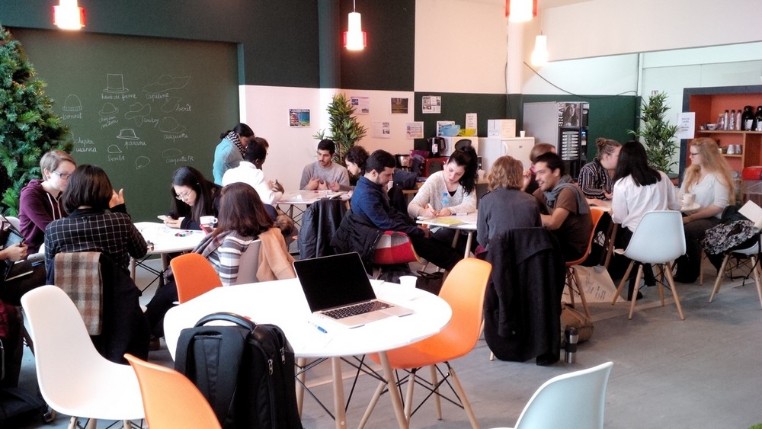
The concept of "World Café" was born in 1995 at an international meeting organized by the "Intellectual Capital Pioneers". The main principles are presented in the works of Juanita Brown and David Isaacs The World Cafe: Shaping Our Futures Through Conversations That Matter. This approach allows students to lose any inhibitions and express themselves more freely. By combining an informal atmosphere (exchange, debate over a coffee) and formal (course), we can create a focus of attention that provides access to a deeper shared knowledge that can be used to answer important questions. Once the introductory course of the theme is completed, the participants are divided into groups that gather around tables in a friendly and relaxed atmosphere. Each group discusses the theme for 10 minutes and then the group members join different tables to "pollinate" them. One member of the group will stay at each table and serve as host to welcome new members and summarize the major ideas of previous conversations. This "pollinating" is repeated several times, during which members can note or draw their ideas on a tablecloth or a flipchart, before all the participants move on to a plenary session to share their discoveries. The "live" posters produced reveal the diversity and richness of the exchanges. Their analysis will provide 10 different hypotheses, which will then be studied by the 10 groups within the framework of the underlying issue that runs throughout the module. Concrete actions and problematization of new issues will be put forward and presented during the final closing conference.
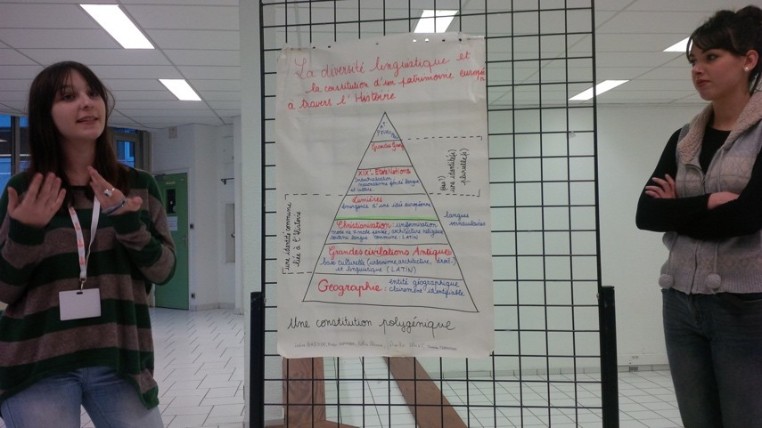
- ProPeace Learning Lab
How to optimize a study stay on Cultural Heritage involving teachers, students and actors? Here is the example of the week spent in Wageningen (organized by our partner Wageningen Environmental Research, the Netherlands) as part of the Propeace Project (16 – 20 January 2017).
1/ Learning outcomes
During an intensive programme of a week the ProPEACE network gathered in Wageningen, the Netherlands, to exchange lectures, discuss its contents, and participate and actively contribute to site visits. By means of an introductory lecture and a shared lunch the ProPEACE network became acquainted with the Wageningen UR chair group Cultural Geography.
The methodology of the learning lab consists of a combination of theoretical lectures, guest lectures and active field visits: this resulted in an oscillating discussion on theory, epistemology, policies, practices, innovations and activism. This was deemed a necessary step towards more mutual understanding and more focus.
Each day a combination was made of an excursion and various lectures. Each lecture lasted approximately 20 minutes, followed up by a plenary discussion of 20 minutes. During the excursions, the site holders were given the opportunity to pose questions or address dilemmas to the ProPEACE network. They have been asked to prepare such issues in advance. This resulted in very lively discussions, in which practical matters and theoretical reflections could cross-fertilize. As a result, several heritage initiatives became part of the ProPEACE network on an informal basis.
During the site visits the following issues (among others) were discussed:
- Heritage in the making; heritage in the periphery, local heritage activism
- Heritage and nature management
- Uncomfortable and contested heritage of black pages in history
- Heritage as a primary bottom up private initiative
- Heritage tourism management, balancing the public and private interests
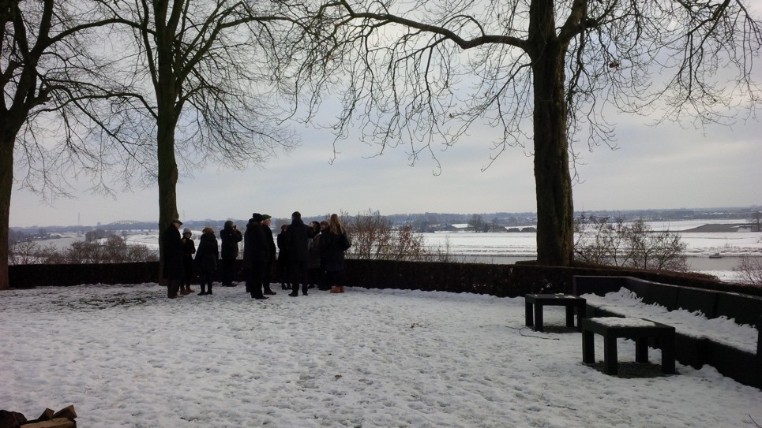
During the lectures the following issues (among others) were discussed:
- Epistemic relations of heritage and culture
- Heritage inclusivity and heritage exclusivity
- Heritage diplomacy
- Heritage and Brexit
- What makes a tourist good or bad?
In between a few guest lectures were given on heritage innovations in Amsterdam and on digital heritage.
The overall learning outcomes can be specified as follows:
- Shared understanding of the concept of European Heritage, although there remained much to discuss;
- Intensive exchange of views how heritage and culture should be conceived, leading to a better understanding, based on various theoretical considerations;
- Discussions on the reasons why heritage is created by some in society increased the mutual understanding of the interplay of politics and civil society;
- Examples from practice learned how European heritage is a matter of strategy and organisation
- Views from outside Europe were extremely useful for achieving a higher level of reflexivity on European culture and its heritage.
A fundamental description of the learning outcomes has been provided by Rakefet Sela-Sheffy (see below).
2/ Methodological implications of the learning outcomes
Below some implications will be discussed regarding the methodology to study and teach cultural heritage issues. These are based on the notion that cultural heritage almost unexclusively seems to be wrapped in ideologies that complicate the academic process of observing and understanding. The positivist tradition that is so widely spread among cultural heritage academic community is not well equipped to look behind the ideologies. Useful alternatives can be found in post-structuralist methodologies.
Epistemic considerations
- Cultural heritage objects should be understood as social constructs that are under permanent construction
- Being social constructs they are subdue to plural objectivation processes, embedded in cultural practices
- Objectivation is the result of signification: meanings attributed to cultural heritage objects by different groups
- Meaning of heritage is strongly connected with the construction of identities and the acquisition of prestige
- The method of studying and teaching cultural heritage should depart from this epistemic point of departure
- Methodological innovations are needed that acknowledge this highly contextual and pluralist nature of cultural heritage in order to:
- Provide academic reflections on the role of politics that inevitable changes the cultural dynamics cultural heritage is embedded in
- Provide academic reflections on the actual and potential role cultural heritage can play in coping with cultural pluralism in society
Methodological innovations
Methodological innovations are necessary to improve our understanding of cultural heritage in society, such as:
- Diachronic analyses that address heritage signification as a co-evolutionary process suspended in different cultural practices, that can be studied with discourse analysis and cultural evolutionary theories
- Deconstruction of cultural heritage ideologies deployed by formal institutions, to reveal innate contradictions and ambiguities of commodification
- Deconstruction of cultural heritage tourism, to reveal the mechanisms that lead to subjectivation of the "cultural heritage mass tourist"
- Field work that reveals the full complexity of cultural claims on cultural heritage
- Inclusion of "citizens science" in the study of cultural heritage practices./
Personal feedback by Rakefet Sela-Sheffy, from Tel Aviv University, Head, Unit of Culture Research, Identity and Environmental Action Laboratory
26.1.2017
Dear Roel and all,
I wish to thank you again, Roel, for so ingeniously organizing and coordinating this intensive five-day workshop in Wageningen. It has been an exciting experience of learning and exchanging thoughts about heritage initiatives, and a perfect opening learning lab for our project partnership.
I found that the program was well balanced between sessions of partners' presentations and discussions, and field visits. A preliminary meeting as it was, the diversity of topics introduced by the different partners provided a good point of departure for fine-tuning the focal questions and tasks of our joint project, a process which obviously should be further elaborated. Naturally, the topics presented by the partners, representing their ongoing research interests, not always directly coincided with problematics that emerged from the field cases (though in some cases the mutual relevance was very clear, especially regarding the Amsterdam heritage-tourism problem, which was also addressed by specific presentations). However, although we had to meet a tight schedule, the time dedicated to presentations + discussions was flexible enough to allow necessary adjustments – including slots for reflecting on the field cases. As we have all agreed, we could have benefited from longer presentations and more time for discussion during the sessions. Yet the time dedicated to the excursions was precious, and should not have been reduced.
The field excursions were very rich and inspiring for me. We have been introduced to a variety of cases of local heritage activism, from urban to rural heritage, human made vs. natural heritage, heritage of historical events vs. canonical cultural assets – and the complex interplay between all these. Within this tight time frame, we were given a glimpse of the intense social energies invested in and stirred by heritage today, in one specific (small) geo-cultural region in Europe. All these individual cases raise a range of important issues for consideration in the ProPeace project, regarding the tension and interplay between the global and the local (national), and cross-European cultural assets. This includes issues such as: Uses and balances of heritage policy at the service of tourism development, and the conflict between it and the protection of local community life (Amsterdam, Lunteren); Nationally-based motivations for commemorating a cross-European event such as WWII (The Liberty Road, Lunteren); Centralized top-down vs. local bottom-up enterprises (Oostenbeek), or public vs. privately owned projects (The Hoge Veluwe national park): Activists' goals and dilemmas, their action methods, as well as the question of mobilizing larger local communities (Oostenbeek); Or the institutionalization and expansion of local initiatives to gain inter-European dimensions, and beyond (The Liberty Road). As I understood it, the focal perspective in all of these cases was that of activists' and policy implementing bodies' goals and dilemmas. What I would have liked to learn more about is the relevant local communities' responses to the different projects in their immediate life zones, in terms of their shared or contested identities, aspirations and concerns.
Also, meeting, as briefly as it was, with scholars and graduate students of Wageningen University, mainly of the Chair groups Cultural Geography, Landscape Architecture and Spatial Planning, was most inspiring for me. I wish we have had more time to get acquainted with their works and talk with them.
This was a very rich and inspiring learning lab. Many thanks to Roel and Marion, to the Alterra Center at Wageningen, to Aurélie, Robet and Jaqueline, and to all the participants in this meeting. I look very much forward to further discussing these issues in the next meeting and to finding common grounds for developing this research network further.
Best regards, Rakefet
Proceedings and impressions of discussions
- The European spirit in the XIXth century: Robert Belot, Jean Monnet University
This lecture showed how the creation of Europe was the result of intellectual philosophical legacies, even from outside Europe. The idea of Europe was clearly discussed.
- Who profits from legacy? Itamar Even-Zohar, Tel Aviv University
This lecture provided the substance for discussing the reasons why heritage exists, even in prehistoric times. Heritage was put in a cultural perspective.
Project output - Lexicon (prepared by Anna Solovyeva).
Discussing the idea of unified concepts and entrees, or allowing different cultural perspectives in the Lexicon.
Excursion: The WW2 heritage of the village of Renkum and Wageningen
Discussing European Heritage Liberation Route and bottom up heritage Oosterbeek in the Airborne museum (Jeroen van Wieringen).
Discussion: what historic figures remain unmentioned and why?
Four estates (Dirk van Uitert and Rob Aben)
Discussion: can the estates areas profit from if part of European Heritage? Is it only of local value? The European Heritage trademark should not stop all development, because it can lead to degradation.
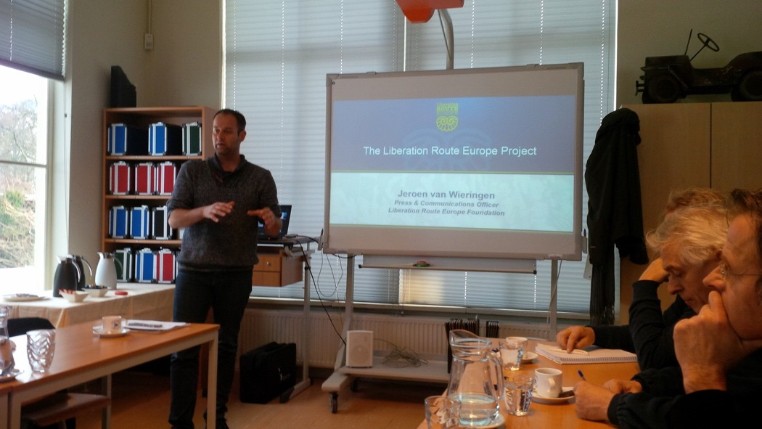
Tuesday 17 January Excursion to Amsterdam
Scheepsvaart museum: discussing the way private actors and the government cooperate here.
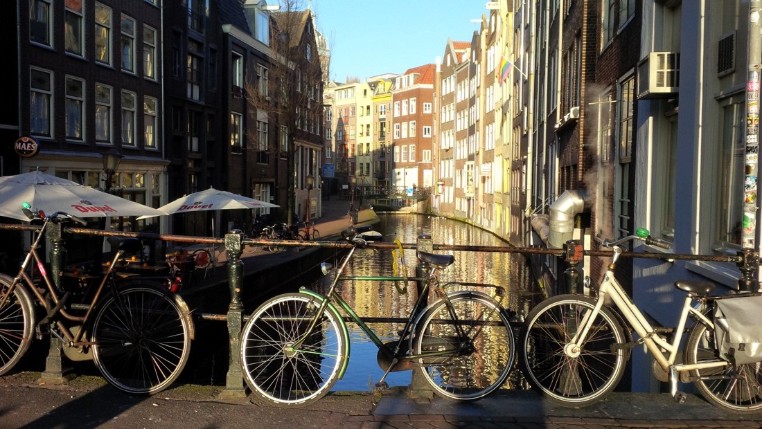
During lunch in De Waag: guest lecture by Karin Westerink, about managing mass tourism in Amsterdam. The inhabitants of the inner-city plea for one tourist and one commuter on one inhabitant as the mix that they could manage. Discussion: the strategies to keep the nuisance of tourists within certain limits. One strategy was to turn anonymous tourists into "friends of Amsterdam" and give some small privileges in return for responsible behaviour.
Oude kerk as a place for the local community, focusing on art exhibitions.
Museum Ons' Lieve Heer op Solder https://www.opsolder.nl/en
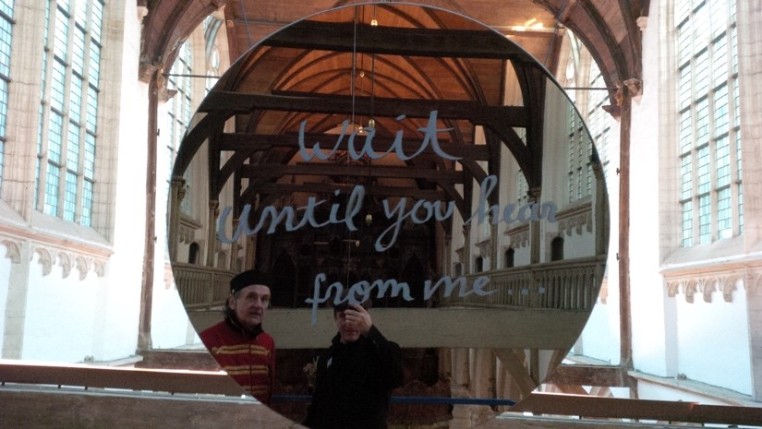
Wednesday 18 January Lumen 2
- Amsterdam, the city with 10 million tourists: Jacqueline Bayon, University St-Etienne.
Discussion: How to divert tourist from the main tourist attractions? It is hard because tourists are generally not interested in these places and it is also more difficult to reach them. You should start informing tourists already in the airport. The Old Church is a place with a quite area for tourists in a busy city.
- Community response to heritage projects. Rakefet Sela-Sheffy
Discussion: Problems of double belongings (new immigrants) and Israeli citizenships? Integration is good, they can vote. The olive oil tradition from the presentation is not different from other traditions. Conflict are often between newly arrived and old habitants. The olive oil is used to look for more understanding? No, people are usually in confrontation. Comments on the internet are very personal and people dispute each other (identity contest). Online discussions are becoming more important, but much anger is coming out. Also, some comments are written by professionals. Online information is not the same as in interviews or questionnaires. It can be biased: only people with much time and interest react. However, the number of comments is enormous and can give a good impression.
- The modern life of the Middle Ages and the Icelandic identity, Anna Solovyeva
Discussion: Itamar: Icelandic nationalism is designed for creating tourism. The Icelandic scientists have "normalized" the Icelandic sagas in a language, which is not authentic, but designed to be different from the Scandinavian languages. Even the presence of Vikings in Iceland is contested. Roel: different time layers starting from first settlement of Iceland. The settlers came probably from many places, many Celtic women slaves (Ireland) and Norwegian male aristocrats.
- Scottish-Polish historic links: Krzysztof Jan Chuchra, EWHT
Who owns/interprets heritage, how can heritage become instrumental?
Discussion: Robert: in '43 proposal for a chair of European humanism. Solidarity between nations during the war. Movie recommended To be or not to be from Ernest Lubitsch. Polish effort was instrumental, but not always visible. Rakefet: the historic events did not become heritage, but was forgotten. Heritage is often used by regimes to build support. It can be used to build bridges instead.
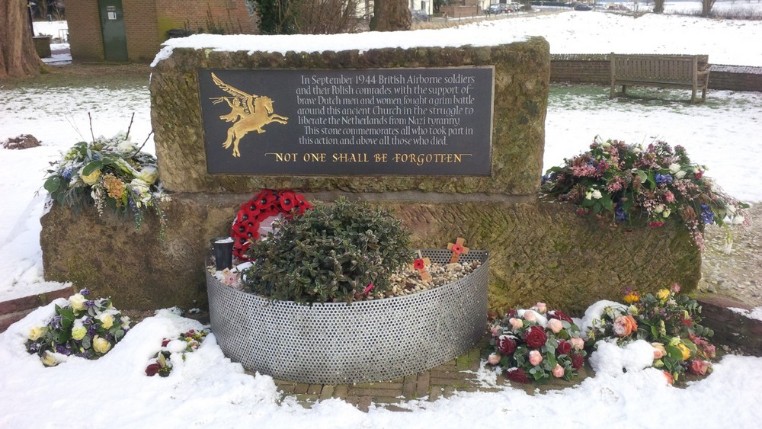
Lunch with Chair groups Cultural Geography, Landscape Architecture and Spatial Planning.
Discussion on (1) hunting practices. Much of the environmental knowledge is derived from hunters in NL. Hunting concerns mostlyt wild boar and deer. (2) Checkpoints in Israel. Translator can interfere with the answers. (3) Explanation of the ProPeace project was given. ProPeace is very divers, difficult to get focus.
Guest lecture by Marco Streefkerk on Digital Heritage Netherlands (www.den.nl)
Discussion: Dutch digitalized newspapers already exist from the 18th century. (National Library of the Netherlands). Europeana: website with digitised objects.
Short excursion to the village of Lunteren and its Wall of Mussert. Restaurant de Goudsberg, Rene van Heiningen (NIOD). Author of the wall of Mussaert. Mr. Wijnand Alderman of Ede Municipality.
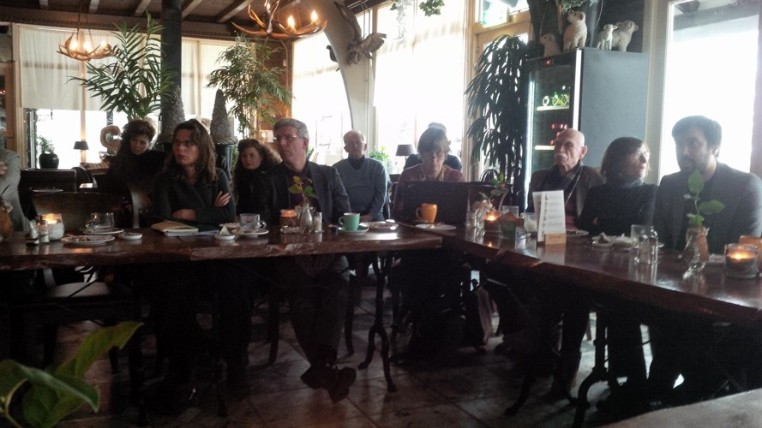
Discussion: Robert: interesting addition to "difficult" heritage. Attention to the black pages is necessary. Mr. Mussaert is different from Seis-Inquart. He not a collaborator, but an "ideological collaborator". During the war the wall of Mussaert had no significance. Musseart himself was always considered a loser. In France, the first exhibition on collaboration took place in 2016, but it was not critical. Danger of instrumentalisation of history. How do people interpret the place? Warning or nostalgia? Need to secure the historical message. You learn more from mistakes.
Kristof: do no rush the process, give people time to speak their minds and listen. Reality can be twisted (for example the flyer in the campaign for Brexit). House of Hitler: discussion is on-going: particular difficult for Austria.
Joost Roosendaal, RU: guilty heritage inventory in Gelderland. Newspapers highlighted it, but there were not many comments. The Jewish paper also found it important to preserve. It was a process of rethinking how to deal with these memories. The Germans have been the first to start the "Malmal" (monument for a black page), for example Nurnberg. The second WW is still very alive in the Netherlands. Roel: local foundation to take leadership and each year unfold a black page in this place. Wijnand: should be a national monument, so that Lunteren is not associated as a collaborator town. Jan van ‘t hof: considering to take responsibility for this issue and speed it up. Shared communication moment soon. Distinction between a monument and a memorial; does this help the discussion? In the communication, this should be considered well. Possibly place of remembrance. Itamar: City of Ferrol in Galicia had the statue of Franco: only 4 years ago removed, but businesses around the square complained of less tourists. Can people really learn from a "Malmal"? Ferr: Dark pages are not for tourists but to conserve history.
Thursday 19 January Gaia 2
Work on the Encyclopedia prepared by Troy van Tran
Discussion: Canada has lots of experience and was asked to manage the process.
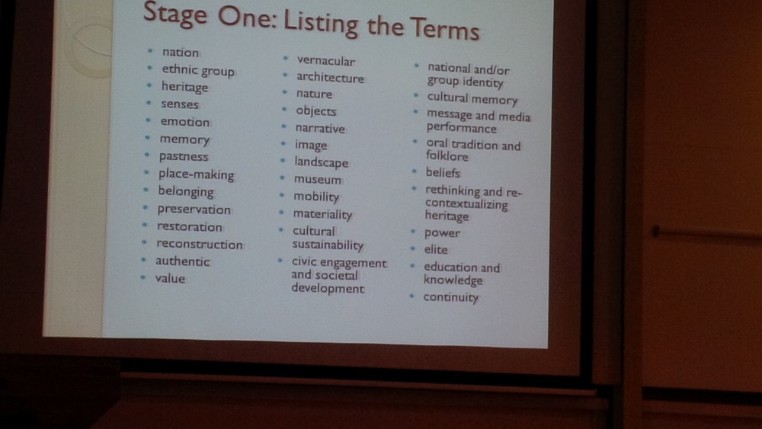
Ambition is have a site like Wikipedia and each partner (1 per year) and students (2 per year) will write articles to have a total of 100 articles to start off. A list of items have been proposed already.
Roel: Will we write from different angles? Be convincing and use empirical evidence?
Discussion on definition:
Itamar: Heritage is different from culture. It contains items that are canonised.
Kristof: Heritage is cultural glue, not exclusive, but bringing together
Itamar: culture cannot persist without canons. Heritage is one type of canon.
Rakefet: Patina principle: things at home that survive ling enough it say something about you. It will make you more important. Groups with "patina" have more respect than groups without and you consider yourself better.
The description of the item is not the most important, but the value that is given.
Krystof: need to focus? Rather have it transnational, European aspect.
Krystof: anyone can contribute? Revision is not decided yet. Cannot be done by one partner only.
Itamar: preparatory work needed to see what was done by others. It should have distinctive features.
Itamar has written many entries, in Wikipedia in the last years. Good to have students write articles, they need technical guidelines, but also agencies involved and processes. Write what is distinguishing and what is connected
Action/Decision: First list of items need to be decided on and which author. Students can choose, but it needs to be coordinated. The list can be expanded. Not just describe the item, but also agencies involved and processes. Write what is distinguishing and what is connected. A short deadline must be set (End of February) to be able to discuss the articles in Edinburgh. Create writing workshops in Edinburgh to harmonise articles.
National Park the Veluwe https://www.hogeveluwe.nl/en and excursion in Jachtslot
Presentation bij Baron Mr. Van Voorst tot Voorst
Tour in Jachthuis Sint Hubertus and short visit to Kroller-Muller
- Roel During European Heritage Pluralism, discussing pluralist mechanisms in heritage in the making of Heavy Metal groups, groups of gamers and football fanclubs.
Friday 20 January Lumen 2
- Lecture by Jorien Posthouwer on heritage from below and in the periphery of Amsterdam.
Discussion: Not to focus solely on heritage, but look at the context and especially the rhetoric of Heritage.
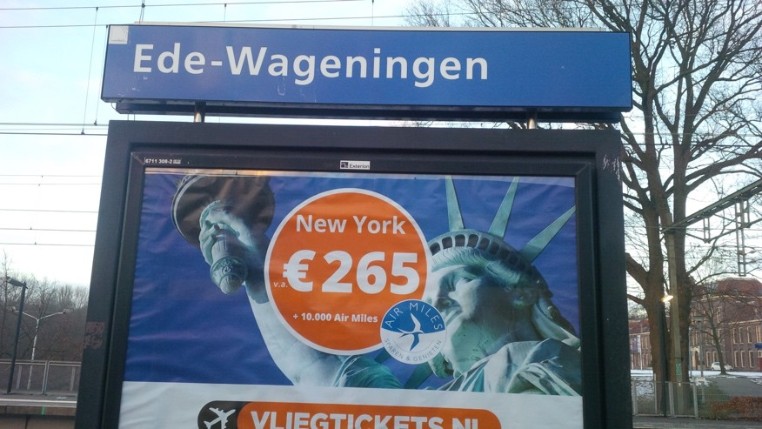
- Lecture by Troy van Tran: Quels patrimoines pour les expositions universelles?
Discussion: Rhetoric is about food, but the objective is marketing. Not really heritage, but a new fashion that can become heritage. Place to learn new marketing and new installations. Almost no distinction between trademark and heritage. Used as argument for and against modernisation. Robert: Coca Cola is heritage, because it is iconic for USA. Krystof: people travel to taste local food, Matty Matheson programme to promote Canadian food. https://munchies.vice.com/en/show/keep-it-canada
- Lecture by Lucretia Lopez: Santiago de Compostela: A World Heritage City.
Discussion: Robert: measure link increase of visitors and new corporations, also before 2005. Effect of TripAdvisor on traveller's choice? Aurelie: Bad and good tourists: spending tourists are not always respectful. What is a good tourist? Roel: European heritage should not enforce the same sites as UNESCO, but support other places. Robert: write the new manifest: with title "zero touristic growth".
Edinburgh preparation
Objectives:
- Encyclopaedia
- Lexicon,
- Students topics discussion
- Workshops between students and partners.
Additional workshop: What is European heritage? This is the output of the partnership.
Meta-approach (use, meaning, connections of heritage) Output that can form policy, needs to be relevant outside the partnership. How European Heritage is challenging local heritage. How local heritage sees European Heritage. Connections between nations, can European Heritage play a role? Raise awareness. Movement "Cultural Heritage across Europe". Discuss the focus of this network and can have an added value towards other networks. Krystof: the structure of the Wageningen meeting is effective, combine discussion with excursions.
Begin the week with instructing the students, see cultural heritage as a concept to unite people, look at European concepts. Then the partnership and students work separately. End of the week come together. Site visit involving whiskey. Rakefet: methodology goes hand-in-hand with a perspective. It does not stand alone. For an encyclopedia interviews are not relevant. Roel: Ask the student to tell a story (video) on what they find European Heritage is and later have them interview each other. Itamar: careful for political consequences. Krystof to propose a programme.
Roel During
Alterra – Foundation DLO
Stichting Dienst Landbouwkundig Onderzoek
The Netherlands
- From a Heritage inherited to a Heritage claimed
The issues raised at Wageningen were debated in Edinburgh and in Cluj. A consensus was built around the notion of cultural heritage and its issues. Here is the result of this discussion.
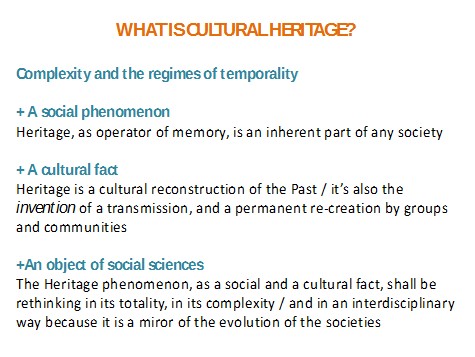
Heritage is not (only) the past, history or memory. It is a transmutation, a pseudomorphosis: society chooses to distinguish in the present what the future must retain / protect from the past. Jean Davallon has spread the notion of "reverse filiation": "We are the ones who decide that we are their heirs and then estimate what we must keep to pass on to those who come after us." In other words, we went from a heritage "inherited" to a heritage "claimed" (Pierre Nora).
There is an extraordinary process of extension; in a few years, we have gone:
- from the "historic monument" to the natural site
- from the spectacular (cathedral) to the vernacular (the village washhouse)
- from State distinction to Community logic
- from material to intangible (landscape, language, traditions, know-how…)
The three stages of recognition:
- inventory and knowledge
- classification, labeling or any form of distinction
- enhancement with a view to sharing
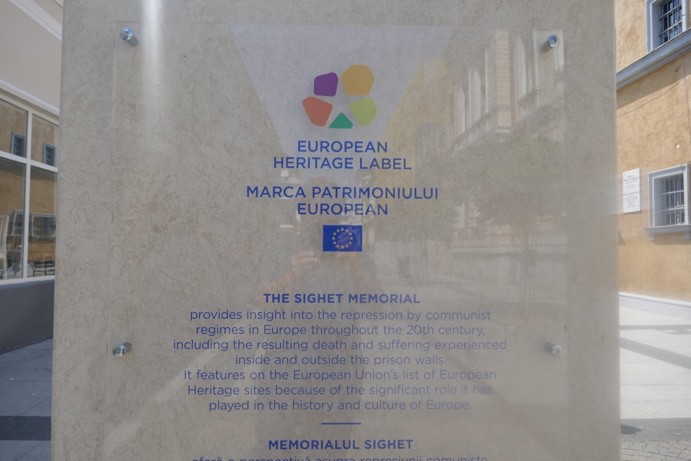
The Sighet Memorial in Romania dedicated to the victims of communism, which would not exist without the support of the Council of Europe @Robert Belot, 2019
The explosion of Heritage:
"Heritage has exploded in every way. In just thirty years, he left the woolen stocking and the historical monument, the church and the castle to take refuge in the village washhouse and in a popular chorus. He escaped from the notarial and the artistic to invade all areas of which he was specifically excluded: the traditional experience, the contemporary still in use and, even, nature. Are not we talking about ethnological heritage, but also genetic, linguistic and, why not, constitutional? Silent and yet decisive revolution. We have moved from state and national heritage to social and community heritage where a group identity is being deciphered; and, therefore, from inherited heritage to a claimed heritage. From material and visible, the heritage has become invisible and symbolic, traces still seizable of a past definitely dead, vestiges charged with a heavy sense, mysterious. In short, in passing ... from a restricted regime to a generalized definition, the heritage has left its historical age, to enter its memorial age: ours."
Pierre Nora, Les Lieux de mémoire, Paris, Gallimard, 1986.
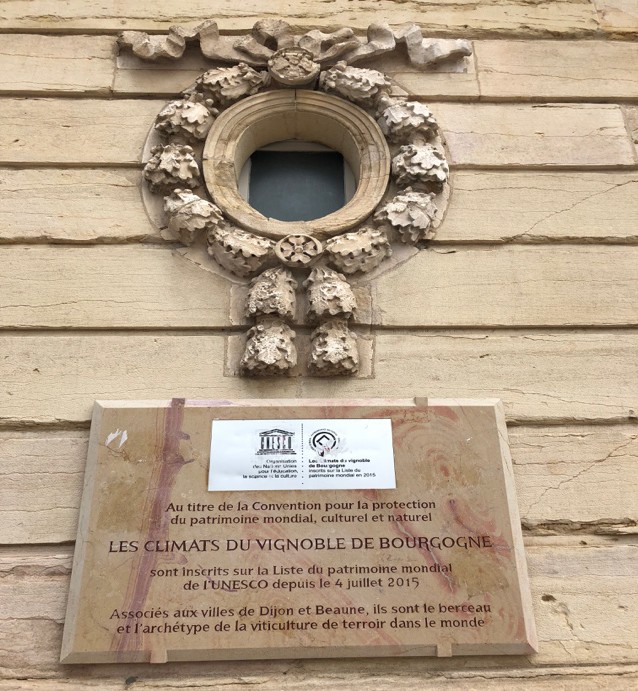
Heritage, more than ever, is a "story of the future"

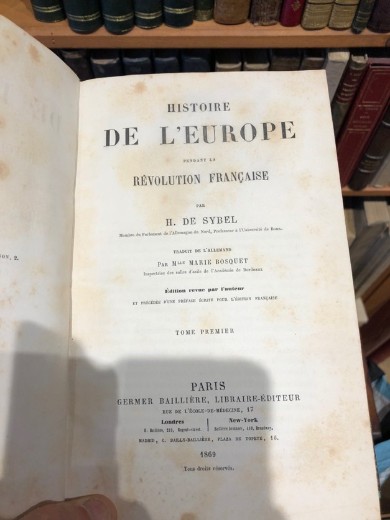
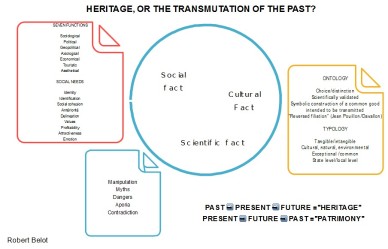
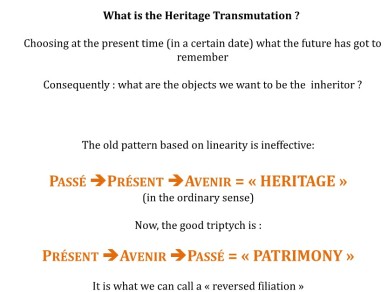
 Université Jean Monnet
Université Jean Monnet